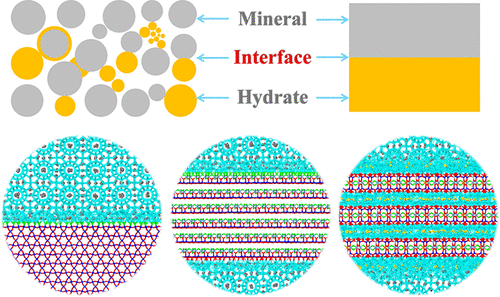当前位置:
X-MOL 学术
›
ACS Appl. Mater. Interfaces
›
论文详情
Our official English website, www.x-mol.net, welcomes your
feedback! (Note: you will need to create a separate account there.)
Mechanical Instability of Methane Hydrate–Mineral Interface Systems
ACS Applied Materials & Interfaces ( IF 8.3 ) Pub Date : 2021-09-14 , DOI: 10.1021/acsami.1c08114 Pinqiang Cao 1, 2, 3, 4 , Tianshu Li 2 , Fulong Ning 1 , Jianyang Wu 3
ACS Applied Materials & Interfaces ( IF 8.3 ) Pub Date : 2021-09-14 , DOI: 10.1021/acsami.1c08114 Pinqiang Cao 1, 2, 3, 4 , Tianshu Li 2 , Fulong Ning 1 , Jianyang Wu 3
Affiliation

|
Massive methane hydrates occur on sediment matrices in nature. Therefore, sediment-based methane hydrate systems play an essential role in the society and hydrate community, including energy resources, global climate changes, and geohazards. However, a fundamental understanding of mechanical properties of methane hydrate–mineral interface systems is largely limited due to insufficient experimental techniques. Herein, by using large-scale molecular simulations, we show that the mechanical properties of methane hydrate–mineral (silica, kaolinite, and Wyoming-type montmorillonite) interface systems are strongly dictated by the chemical components of sedimentary minerals that determine interfacial microstructures between methane hydrates and minerals. The tensile strengths of hydrate–mineral systems are found to decrease following the order of Wyoming-type montmorillonite- > silica- > kaolinite-based methane hydrate systems, all of which show a brittle failure at the interface between methane hydrates and minerals under tension. In contrast, upon compression, methane hydrates decompose into water and methane molecules, resulting from a large strain-induced mechanical instability. In particular, the failure of Wyoming-type montmorillonite-based methane hydrate systems under compression is characterized by a sudden decrease in the compressive stress at a strain of around 0.23, distinguishing it from those of silica- and kaolinite-based methane hydrate systems under compression. Our findings thus provide a molecular insight into the potential mechanisms of mechanical instability of gas hydrate-bearing sediment systems on Earth.
中文翻译:

甲烷水合物-矿物界面系统的机械不稳定性
大量的甲烷水合物发生在自然界的沉积基质上。因此,基于沉积物的甲烷水合物系统在社会和水合物群落中发挥着重要作用,包括能源资源、全球气候变化和地质灾害。然而,由于实验技术不足,对甲烷水合物-矿物界面系统的机械性能的基本理解在很大程度上受到限制。在这里,通过使用大规模分子模拟,我们表明,甲烷水合物-矿物(二氧化硅、高岭石和怀俄明型蒙脱石)界面系统的力学性质强烈受沉积矿物的化学成分决定,这些化学成分决定了甲烷之间的界面微结构。水合物和矿物质。发现水合物-矿物系统的拉伸强度按照怀俄明型蒙脱石->二氧化硅->高岭石基甲烷水合物系统的顺序降低,所有这些系统都在张力作用下在甲烷水合物和矿物之间的界面处表现出脆性破坏。相反,在压缩时,甲烷水合物分解为水和甲烷分子,这是由大应变引起的机械不稳定性造成的。特别是,怀俄明型蒙脱石基甲烷水合物系统在压缩下失效的特征是压缩应力在 0.23 左右的应变突然下降,这与压缩下的二氧化硅和高岭石基甲烷水合物系统不同.
更新日期:2021-09-29
中文翻译:

甲烷水合物-矿物界面系统的机械不稳定性
大量的甲烷水合物发生在自然界的沉积基质上。因此,基于沉积物的甲烷水合物系统在社会和水合物群落中发挥着重要作用,包括能源资源、全球气候变化和地质灾害。然而,由于实验技术不足,对甲烷水合物-矿物界面系统的机械性能的基本理解在很大程度上受到限制。在这里,通过使用大规模分子模拟,我们表明,甲烷水合物-矿物(二氧化硅、高岭石和怀俄明型蒙脱石)界面系统的力学性质强烈受沉积矿物的化学成分决定,这些化学成分决定了甲烷之间的界面微结构。水合物和矿物质。发现水合物-矿物系统的拉伸强度按照怀俄明型蒙脱石->二氧化硅->高岭石基甲烷水合物系统的顺序降低,所有这些系统都在张力作用下在甲烷水合物和矿物之间的界面处表现出脆性破坏。相反,在压缩时,甲烷水合物分解为水和甲烷分子,这是由大应变引起的机械不稳定性造成的。特别是,怀俄明型蒙脱石基甲烷水合物系统在压缩下失效的特征是压缩应力在 0.23 左右的应变突然下降,这与压缩下的二氧化硅和高岭石基甲烷水合物系统不同.











































 京公网安备 11010802027423号
京公网安备 11010802027423号